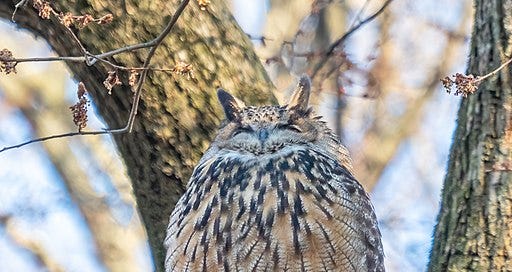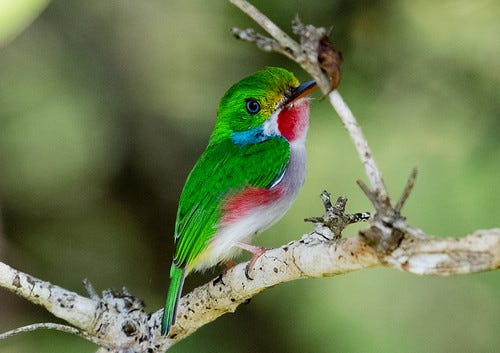(Listen to the radio version here.)
Exactly one year ago this week, I migrated my blog to Substack. Thank you to everyone who subscribes! And a huge thank you to every one of the 111 people who has a paid subscription. This blog represents over 95 percent of my income now, and YOU are the ones who made my trip to Hawaii possible.
My very first post here was about Flaco, the Eurasian Eagle-Owl who hatched at the Sylvan Heights Bird Park in Scotland Neck, North Carolina in 2010 and was quickly transferred to the Central Park Zoo, where he spent the next 13 years, right up until a vandal shredded his mesh enclosure in February 2023. Immediately, a great many people starting rooting for the owl as some sort of romanticized freedom fighter, posting lots of criticism about efforts by the zoo to try to recapture the bird. I read more than one “Live free or die!” comment.
I wondered how many people would be saying “Live free or die” if their own personal price for freedom was to be restricted to a food supply laced with rat poison, as Flaco’s New York City “wild” diet was guaranteed to be. I spent a lot of time visiting my daughter in New York while she lived there—we had to be very careful walking her dog, especially at night, to make sure Muxy didn’t pick up any dead or dying rats or sniff out any of the poisoned baits set out to attract those rats. Either could be anywhere, and in the dark, she could have swallowed something dangerous without our even realizing it.
But freedom is such a deeply rooted, if nebulous, value for Americans that even I, knowing all the dangers Flaco faced, couldn’t help but engage in some of that same romanticized magical thinking about him, hoping that against all odds he could live long and prosper in the Big Apple. Indeed, my first post about him was addressing the silly question about whether birders could put Eurasian Eagle-Owl on their life list after seeing Flaco.
And why couldn’t Flaco do well in New York? Peregrine Falcons famously thrive in large cities, but not by eating rats or other rodents. Many of them do become experts at catching pigeons, but they’re hunting pigeons in flight, not on the ground, so there is some selection at play ensuring that most of the pigeons they target are healthy. Also, those Peregrines are experts at hunting migratory birds passing through those cities as well as local birds. People have long recognized that Peregrines hunt from the Empire State Building at night, grabbing migrating birds disoriented by the building’s lights. So even the most urbane of Peregrine Falcons aren’t likely to eat much poisoned meat, if any at all.

Pale Male, the famous Red-tailed Hawk who nested for many years on a building across from Central Park, had multiple mates over his long life not because Red-tailed Hawks are into serial monogamy but because his mates did not enjoy such long lives. And no one tracked the young red-tails Pale Male raised to know how long they survived. We do know that despite his nesting there for so many years, the number of Red-tailed Hawks in the city did not go up. The local news outlet The City reported on Monday that many of the nine dead birds the city’s Parks Department sent to the state’s Department of Environmental Conservation last year for a cause-of-death determination, including several Red-tailed Hawks, had been poisoned by rodenticides.
Owls are designed to primarily hunt animals on the ground. They grab rodents, birds, and other prey that can’t escape in time. Barry, a famous female Barred Owl living in Central Park during the pandemic died in a collision with a Central Park Conservancy vehicle in August 2021. A necropsy showed that she had a potentially lethal level of rat poison in her body.

I’m a human being who carries non-lethal levels of rat poison in my own body all the time. Warfarin is the anti-coagulant that at manageable levels keeps blood from clotting in the aneurism I happen to have on my right coronary artery. Every two weeks I test my clotting rate to make sure the level is safe for daily life, and I wear a tag on my wristwatch band so if I’m ever in an accident, first responders will know to pump me up with Vitamin K to prevent my bleeding out. At best, windows kill about 50 percent of the birds who collide, even when those birds seem fine and fly off. That rate must be far higher in birds carrying rat poisons in their blood.
When Flaco died last month after colliding with a window in the Upper West Side, the obvious cause was the window. But when the International Owl Center saw the initial necropsy result, they noted that the bleeding behind one eye with no evidence of head trauma, and the substantial hemorrhage under the sternum and in the back of the body cavity around the liver, suggested that his body was burdened with anticoagulant rodenticides, which cause exactly this kind of internal hemorrhaging.
Sure enough, this week the final results of the necropsy were released. Flaco had not just one kind of rat poison in his system but FOUR, at levels high enough to have killed him without his even hitting a window. He also had dangerous levels of a pigeon herpesvirus in his system, which caused severe tissue damage and inflammation in many organs, including the spleen, liver, gastrointestinal tract, bone marrow, and brain. Even healthy pigeons can carry this virus, but it’s dangerous for birds of prey. Both the rat poisons and this virus may have led to enough disorientation to have caused the window collision in the first place.
Scarily, the necropsy also revealed that Flaco had low levels of DDE in his tissues. DDE is a metabolite of the pesticide DDT, which was banned in the 1970s but is one of those “forever chemicals” that remain in the environment long after it stops being produced.
What a world we’ve created for our children and other precious living things.
We sometimes envision freedom as the right to do whatever we please and go wherever we want, but any American who’s tried to use or take other people’s property, or even just wants to travel to a neighboring country to see Cuban Todies in the wild, knows that even for us, freedom has limitations.
Franklin Roosevelt suggested four fundamental freedoms that every human being should enjoy—freedom of speech, freedom to worship God however we choose, freedom from want, and freedom from fear. In his large Central Park enclosure, Flaco enjoyed all four of those freedoms.
I’d suggest that there is another fundamental freedom—freedom to eat, drink, and breathe food, water, and air safe from toxins. Ironically but truly, without that one profoundly essential freedom, Flaco lost his freedom the moment that vandal sliced open his cage.







